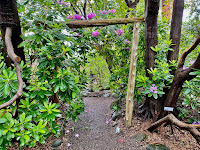Mytoi is a Japanese inspired garden located on Chappaquiddick Island, near Martha's Vineyard, off the coast of Massachusetts. It is an unusual location for a Japanese garden, the weather extremes being one factor of its current configuration.
Created by Hugh Jones, an architect who was given the land for $1 as payment for building a Japanese style home for local conservationist Mary Wakeman, the garden reflects Jones' interest in Japanese art and culture. Jones worked on designing and building the garden largely on his own. He named it "my toy," hence the current name of Mytoi. Following his death in 1965 the garden was returned to Mary Wakeman who then donated the garden in 1976 to the Trustees of Reservations.
In 1991, Hurricane Bob essentially destroyed much of the garden as built by Hugh Jones. The Trustees then embarked on a restoration/rebuild of the garden led by the team of Don Sibley and Julie Moir Messervy.
Website: https://thetrustees.org/place/mytoi/
Although the garden is often described as "Japanese inspired," I would argue that it is as much a Japanese garden as any that I have seen. It has several major features associated with a traditional Japanese garden: hills and pond, a resting house, and a hide and reveal, and stroll garden elements.
Upon entering I was disappointed that I had seemingly missed the blooming of Rhododendrons. However, I quickly discovered that different areas of the garden were in different stages of blooming: the entry way had bloomed and passed, the central area near the stone bridge was in the midst of dropping petals that were still vibrant and intact, the pond area in full bloom. It appeared that I came to visit at the optimum time to see all the stages, each beautiful in their own right.
There were a few elements, such as a lantern, moss garden with checkerboard tiles, an inner gate, wooden bridges, and a Tsukubai water fountain. Keeping these elements minimized lent itself to a more simple, understated, and authentic experience
The Sukiya style for the inner gate was also a nice design idea.
The small stream leading to the pond, covered with fallen blooms, was stunning. My timing was perfect to be able to observe this momentary existence of beauty.
Opening up to the Pondside Path, one is confronted with a sweeping view of the pond with a variety of plantings that provided a differentiated palette of foliage colors and shades.
The Stone Garden was a very well planned out feature, similar to what I had seen at the Gan Ryuu Tei, the Japanese garden located at the Cleveland Botanical Garden. However, it was in need of some maintenance. I was informed that deer had been a constant problem in this particular area. Perhaps some more deer resistant plantings could be used in any future restoration.
The areas in direct sunlight, outside of the initial shady entryway, were still demonstrating full blooms.
The zig-zag bridge across the pond was a nice feature. However, I was not a fan of the initial arched bridge, its top pieces seemingly inauthentic. On the other hand, I appreciated the low profile of the railings along the remainder of the zig-zag bridge.
A lone Scarlet Fire Dogwood was a really nice feature in the Natural Garden. The small Bamboo grove and occasional Dwarf Maples also contributed to the authenticity of the garden.
The Azumaya (resting place) was located at a top of a hill with steps and a winding path offering the visitor multiple perspective from which to view the structure and the pond below. This was one of my favorite features of the garden. Once seated in the Azumaya, the view was breathtaking.
A final stroll through the Cedar Hill exposes the visitor to even more Rhododendrons and an occasion glimpse of stones. A most calming and pleasant experience.
After the complicated journey to get to the islands, I was pleasantly surprised to find a much larger garden than I expected. Its many features are more than inspired by Japanese garden design. It is an excellent example of a North American Japanese garden and well worth a visit.



















































